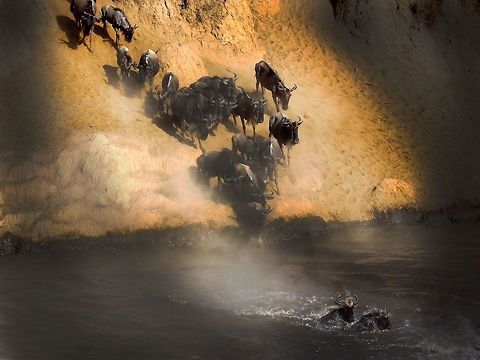
Appearance
The blue wildebeest exhibits sexual dimorphism, with males being larger and darker than females. The blue wildebeest is typically between 170–240 cm in head-and-body length. The average height of the species is 115–145 cm. While males weigh up to 290 kg, females seldom exceed 260 kg. A characteristic feature is the long, black tail, which is around 60–100 cm in length. All features and markings of this species are bilaterally symmetrical for both sexes. The average life span is 20 years in the wild, and 21 years in captivity. The oldest known captive individual lived for 24.3 years.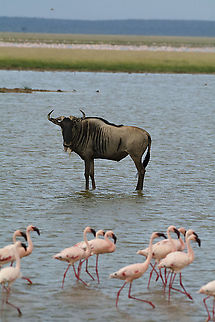
Naming
The blue wildebeest was first described by English naturalist William John Burchell in 1823 and he gave it the scientific name "Connochaetes taurinus". It shares the genus "Connochaetes" with the black wildebeest, and is placed in the family Bovidae, ruminant animals with cloven hooves. The generic name "Connochaetes" derives from the Greek words κόννος, kónnos, "beard", and χαίτη, khaítē, "flowing hair", "mane". The specific name "taurinus" originates from the Greek word "tauros", which means a bull or bullock. The common name "blue wildebeest" refers to the conspicuous, silvery-blue sheen of the coat, while the alternative name "gnu" originates from the name for these animals used by the Khokloi people, a native pastoralist people of southwestern Africa.Though the blue and black wildebeest are currently classified in the same genus, the latter was previously placed in a separate genus, "Gorgon". In a study of the mitotic chromosomes and mtDNA which was undertaken to understand more of the evolutionary relationships between the two species, it was found that the two had a close phylogenetic relationship and had diverged about a million years ago."C. taurinus" has five subspecies:
⤷ "C. t. taurinus" is found in southern Africa. Its range extends from Namibia and South Africa to Mozambique and from southwestern Zambia to southern Angola.
⤷ "C. t. johnstoni", occurs from Mozambique to east-central Tanzania. This subspecies is now extinct in Malawi.
⤷ "C. t. albojubatus", is found in the Gregory Rift Valley. Its range extends from northern Tanzania to central Kenya.
⤷ "C. t. mearnsi", is found in northern Tanzania and southern Kenya. Its range extends from the west of the Gregory Rift Valley to Speke Bay on Lake Victoria.
⤷ "C. t. cooksoni", is restricted to the Luangwa Valley in Zambia. Sometimes these animals may wander into the plateau region of central Malawi.
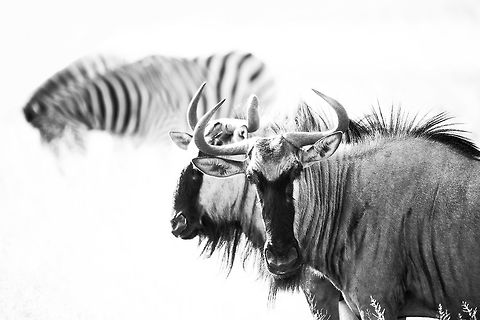
Distribution
The blue wildebeest is native to Kenya, Tanzania, Botswana, Zambia, Zimbabwe, Mozambique, South Africa, Swaziland and Angola. Today it is extinct in Malawi, but has been successfully reintroduced into Namibia.Blue wildebeest are mainly found in short grass plains bordering bush-covered acacia savannas in southern and eastern Africa, thriving in areas that are neither too wet nor too arid. They can be found in habitats that vary from overgrazed areas with dense bush to open woodland floodplains. Trees such as "Brachystegia" and "Combretum" are common in these areas. Blue wildebeest can tolerate arid regions as long as a potable water supply is available, normally within about 15–25 km distance. The southern limit of the blue wildebeest stops at the Orange River, while the western limit is bounded by Lake Victoria and Mt Kenya. The range does not include montane or temperate grasslands. These wildebeest are rarely found at altitudes in excess of 1,800–2,100 m. With the exception of a small population of Cookson's wildebeest that occurs in the Luangwa Valley, the wildebeest is absent in the wetter parts of the southern savanna country, and particularly is not present in miombo woodlands.
Three African populations of blue wildebeest take part in a long-distance migration, timed to coincide with the annual pattern of rainfall and grass growth on the volcanic soil short-grass plains where they can find the nutrient-rich forage necessary for lactation and calf growth. The timing of the migration in both directions can vary considerably from year to year. At the end of the rainy season, they migrate to dry-season areas in response to a lack of drinking water. When the rainy season begins again a few months later, the animals trek back to their wet-season range. These movements and access to nutrient rich forage for reproduction allow migratory wildebeest populations to grow to much larger numbers than resident populations. There were many long-distance migratory populations of wildebeest 100 years ago, but currently all but three migrations have been disrupted, cut off, and lost.
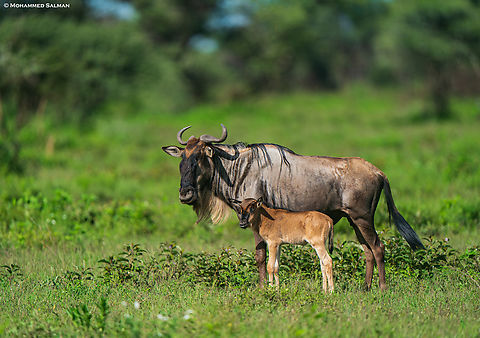
Status
The blue wildebeest is preyed on by lions, leopards, African wild dogs and hyenas and predation is the main cause of death. They are also prone to outbreaks of disease which may also lead to a decline in numbers. Major human-related factors affecting populations include large-scale deforestation, the drying up of water sources, the expansion of settlements and poaching. Diseases of domestic cattle such as sleeping sickness can be transmitted to the animals and take their toll. The erection of fences that interrupt traditional migratory routes between wet and dry-season ranges have resulted in mass death events when the animals become cut off from water sources and the areas of better grazing they are seeking during droughts. A study of the factors influencing wildebeest populations in the Maasai Mara ecosystem revealed that the populations had undergone a drastic decline of around 80% from about 119,000 individuals in 1977 to around 22,000 twenty years later. The major cause of this was thought to be the expansion of agriculture, which led to the loss of wet season grazing and the traditional calving and breeding ranges. Similarly, drastic declines have recently occurred in the Tarangire wildebeest migration.The total number of blue wildebeest is estimated to be around 1,550,000. The population trend overall is stable and the numbers in the Serengeti National Park have increased to about 1,300,000. The population density ranges from 0.15/km2 in Hwange and Etosha National Parks to 35/km2 in Ngorongoro Crater and Serengeti National Park where they are most plentiful. Blue wildebeest have also been introduced into a number of private game farms, reserves and conservancy areas. For these reasons, the International Union for Conservation of Nature rates the blue wildebeest as being of Least Concern. However, the numbers of the eastern white-bearded wildebeest have seen a steep decline in numbers to a current level of probably 6,000 to 8,000 animals and this is causing some concern.
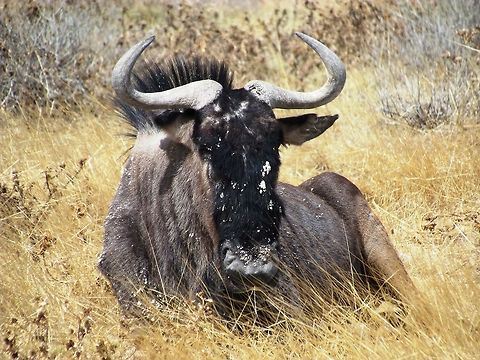
Behavior
The blue wildebeest is mostly active during the morning and the late afternoon, with the hottest hours of the day being spent in rest. These extremely agile and wary animals can run at speeds of up to 80 km/h, waving their tails and tossing their heads. An analysis of the activity of blue wildebeest at the Serengeti National Park showed that the animals devoted over half of their total time to rest, 33% to grazing, 12% to moving about and a little to social interactions. However, there were variations among different age and sex groups.The wildebeest usually rest close to others of their kind and move about in loose aggregations. Males form bachelor herds, and these can be distinguished from juvenile groups by the lower amount of activity and the spacing between the animals. Around 90% of the male calves join the bachelor herds before the next mating season. Bulls become territorial at the age of four or five years, and become very noisy and active. The bulls tolerate being close to each other and a square kilometre of plain can accommodate 270 bulls. Most territories are of a temporary nature and fewer than a half of the male population hold permanent territories. In general, blue wildebeest rest in groups of a few to thousands at night, with a minimum distance of 1–2 m between individuals. They are a major prey item for lions, cheetahs, leopards, African wild dogs, hyenas, and crocodiles.
Bulls mark the boundaries of their territories with heaps of dung and with secretions from their scent glands. The territories are advertised by their behaviour as well as by the physical marking. Body language used by a territorial male includes standing tall with an erect posture, profuse ground pawing and horning, frequent defecation, rolling and bellowing, the sound "ga-noo" being produced. When competing over territory, males grunt loudly, paw the ground, make thrusting motion with their horns, and perform other displays of aggression.
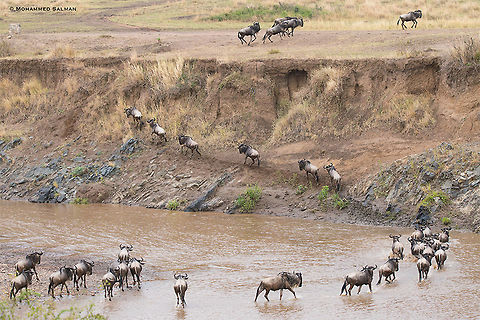
Habitat
The blue wildebeest is mostly active during the morning and the late afternoon, with the hottest hours of the day being spent in rest. These extremely agile and wary animals can run at speeds of up to 80 km/h, waving their tails and tossing their heads. An analysis of the activity of blue wildebeest at the Serengeti National Park showed that the animals devoted over half of their total time to rest, 33% to grazing, 12% to moving about and a little to social interactions. However, there were variations among different age and sex groups.The wildebeest usually rest close to others of their kind and move about in loose aggregations. Males form bachelor herds, and these can be distinguished from juvenile groups by the lower amount of activity and the spacing between the animals. Around 90% of the male calves join the bachelor herds before the next mating season. Bulls become territorial at the age of four or five years, and become very noisy and active. The bulls tolerate being close to each other and a square kilometre of plain can accommodate 270 bulls. Most territories are of a temporary nature and fewer than a half of the male population hold permanent territories. In general, blue wildebeest rest in groups of a few to thousands at night, with a minimum distance of 1–2 m between individuals. They are a major prey item for lions, cheetahs, leopards, African wild dogs, hyenas, and crocodiles.
Bulls mark the boundaries of their territories with heaps of dung and with secretions from their scent glands. The territories are advertised by their behaviour as well as by the physical marking. Body language used by a territorial male includes standing tall with an erect posture, profuse ground pawing and horning, frequent defecation, rolling and bellowing, the sound "ga-noo" being produced. When competing over territory, males grunt loudly, paw the ground, make thrusting motion with their horns, and perform other displays of aggression.The blue wildebeest is native to Kenya, Tanzania, Botswana, Zambia, Zimbabwe, Mozambique, South Africa, Swaziland and Angola. Today it is extinct in Malawi, but has been successfully reintroduced into Namibia.
Blue wildebeest are mainly found in short grass plains bordering bush-covered acacia savannas in southern and eastern Africa, thriving in areas that are neither too wet nor too arid. They can be found in habitats that vary from overgrazed areas with dense bush to open woodland floodplains. Trees such as "Brachystegia" and "Combretum" are common in these areas. Blue wildebeest can tolerate arid regions as long as a potable water supply is available, normally within about 15–25 km distance. The southern limit of the blue wildebeest stops at the Orange River, while the western limit is bounded by Lake Victoria and Mt Kenya. The range does not include montane or temperate grasslands. These wildebeest are rarely found at altitudes in excess of 1,800–2,100 m. With the exception of a small population of Cookson's wildebeest that occurs in the Luangwa Valley, the wildebeest is absent in the wetter parts of the southern savanna country, and particularly is not present in miombo woodlands.
Three African populations of blue wildebeest take part in a long-distance migration, timed to coincide with the annual pattern of rainfall and grass growth on the volcanic soil short-grass plains where they can find the nutrient-rich forage necessary for lactation and calf growth. The timing of the migration in both directions can vary considerably from year to year. At the end of the rainy season, they migrate to dry-season areas in response to a lack of drinking water. When the rainy season begins again a few months later, the animals trek back to their wet-season range. These movements and access to nutrient rich forage for reproduction allow migratory wildebeest populations to grow to much larger numbers than resident populations. There were many long-distance migratory populations of wildebeest 100 years ago, but currently all but three migrations have been disrupted, cut off, and lost.
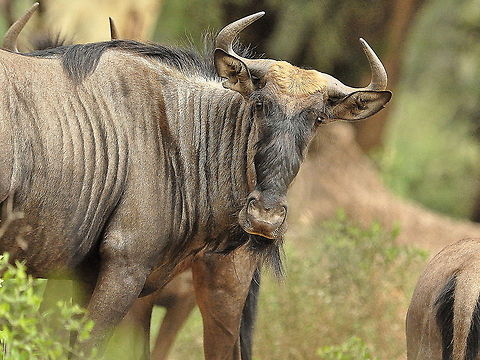
Reproduction
Male blue wildebeest become sexually mature at about two years of age while females can conceive at sixteen months if adequately nourished. Nevertheless, most females do not start to breed until a year later. The mating season, which lasts for about three weeks, coincides with the end of the rainy season. This means that the animals are in good condition, having been feeding on highly nutritious new grass growth, and the conception rate is often as high as 95%. The mating season, or rut, typically begins on the night of a full moon, suggesting that the lunar cycle influences breeding. At this time, testosterone production peaks in males, resulting in increased calling and territorial behaviour. The activities of these sexually excited males may also stimulate female to come into estrus.As they stake out their territories and compete for females, males exhibit rivalry. When they clash, they face up to each other with bent knees and exchange horn thrusts. Elaborate individual displays are made during their rivalry and they may bellow, snort and dig their horns into the ground. Once dominance has been established, each male attempts to lure the female into his domain. During courtship, urination and low-stretch are common activities and the male soon attempts to mount the female. A receptive female holds her tail to one side and stands still while copulation takes place. Matings may be repeated several times and may take place twice or more times within a minute. The male neither eats nor rests when a female is present in his territory and during this time, the female keeps close to the male, often rubbing her head on his torso and sniffing his penis. While in season, a female may visit several territories and mate with several different males.
The gestation period is about eight and a half months and between 80 and 90% of the calves are born within a three-week time period. Female wildebeest give birth in the middle of a herd rather than alone, and typically in the middle of the day. This allows time for the newborn to become steady on its feet before night falls and the predators become more active. Calves weigh about 19 kg at birth, and can usually stand on their own within a few minutes of birth. To escape predation, calves remain close to their mothers for a significant time, and may continue suckling until the next year's calf is nearly due. Some calves leave their mother at about eight months and form herds with other juveniles. In large female herds, 80% of the wildebeest offspring survive the first month, compared to a 50% survival rate in smaller herds.
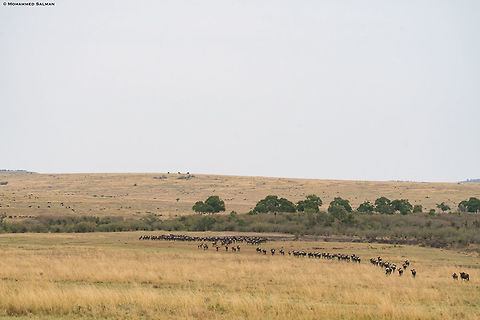
Food
The blue wildebeest is a herbivore, feeding primarily on the short grasses which commonly grow on light, and alkaline soils that are found in savanna grasslands and on plains. The animal's broad mouth is adapted for eating large quantities of short grass and it feeds both during the day and night. When grass is scarce, it will also eat the foliage of shrubs and trees. Wildebeest commonly associate with plains zebras as the latter eat the upper, less nutritious grass canopy, exposing the lower, greener material which the wildebeest prefer. Whenever possible, the wildebeest likes to drink twice daily and due to its regular requirement for water, it usually inhabits moist grasslands and areas with available water sources. The blue wildebeest drinks 9 to 12 litres of water every one to two days. Despite this, it can also survive in the arid Kalahari desert, where it obtains sufficient water from melons and water-storing roots and tubers.In a study of the dietary habits of the wildebeest, the animals were found to be feeding on the three dominant grasses of the area, namely : "Themeda triandra", "Digitaria macroblephara" and "Pennisetum mezianum". The time spent grazing increased by about 100% during the dry season. Though the choice of diet remained the same in both the dry and the wet season, the animals were more selective during the latter.

Predators
The blue wildebeest is preyed on by lions, leopards, African wild dogs and hyenas and predation is the main cause of death. They are also prone to outbreaks of disease which may also lead to a decline in numbers. Major human-related factors affecting populations include large-scale deforestation, the drying up of water sources, the expansion of settlements and poaching. Diseases of domestic cattle such as sleeping sickness can be transmitted to the animals and take their toll. The erection of fences that interrupt traditional migratory routes between wet and dry-season ranges have resulted in mass death events when the animals become cut off from water sources and the areas of better grazing they are seeking during droughts. A study of the factors influencing wildebeest populations in the Maasai Mara ecosystem revealed that the populations had undergone a drastic decline of around 80% from about 119,000 individuals in 1977 to around 22,000 twenty years later. The major cause of this was thought to be the expansion of agriculture, which led to the loss of wet season grazing and the traditional calving and breeding ranges. Similarly, drastic declines have recently occurred in the Tarangire wildebeest migration.The total number of blue wildebeest is estimated to be around 1,550,000. The population trend overall is stable and the numbers in the Serengeti National Park have increased to about 1,300,000. The population density ranges from 0.15/km2 in Hwange and Etosha National Parks to 35/km2 in Ngorongoro Crater and Serengeti National Park where they are most plentiful. Blue wildebeest have also been introduced into a number of private game farms, reserves and conservancy areas. For these reasons, the International Union for Conservation of Nature rates the blue wildebeest as being of Least Concern. However, the numbers of the eastern white-bearded wildebeest have seen a steep decline in numbers to a current level of probably 6,000 to 8,000 animals and this is causing some concern.

Evolution
The diploid number of chromosomes in the blue wildebeest is 58. Chromosomes were studied in a male and a female wildebeest. In the female, all except a pair of very large submetacentric chromosomes were found to be acrocentric. Metaphases were studied in the male's chromosomes, and very large submetacentric chromosomes were found there as well, similar to those in the female both in size and morphology. the rest were acrocentric. The X chromosome is a large acrocentric while the Y chromosome a minute one.This species of wildebeest seems to have evolved around 2.5 million years ago. The black wildebeest is believed to have diverged from the blue wildebeest to become a distinct species around a million years ago, in the mid to late Pleistocene. Fossil evidence suggests that the blue wildebeest were quite common in the Cradle of Humankind in the past. Apart from eastern Africa, fossils are commonly found in Elandsfontein, Cornelia and Florisbad.
References:
Some text fragments are auto parsed from Wikipedia.